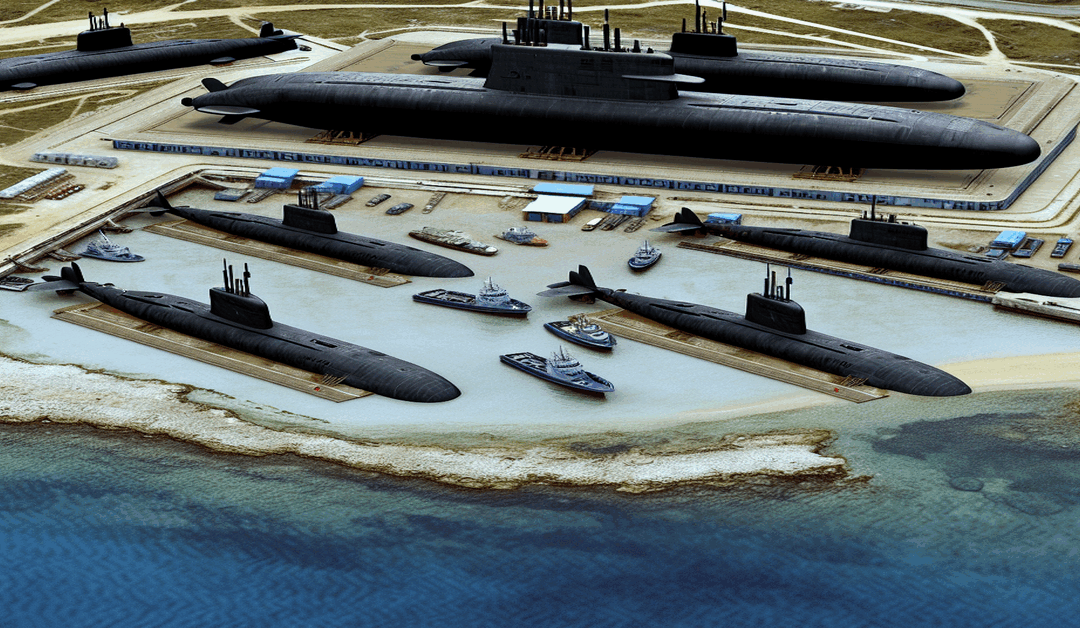Unveiling China’s Hidden Submarine Fleet: Satellite Images Reveal Nuclear Prowess
In a stunning revelation, recent satellite images captured by Google Earth have shed light on a previously less visible Chinese naval base, exposing a formidable fleet of nuclear submarines. The images showcase at least six nuclear submarines nestled at the Qingdao First Submarine Base in Shandong, China, offering a rare glimpse into the country’s expanding naval capabilities.
The satellite imagery, which has been making waves in the defense and intelligence communities, provides an unprecedented look at China’s submarine arsenal. Among the vessels captured are two Type 091 submarines, China’s first-generation nuclear attack submarines, and two more advanced Type 093A submarines. These nuclear-powered submarines are designed to carry out a range of missions, from anti-ship warfare to intelligence gathering and special operations.
A Glimpse into China’s Nuclear Submarine Program
One of the most notable sightings in the satellite images is China’s lone Type 092 ballistic missile submarine. While this submarine has been replaced by the newer Type 094, its presence at the Qingdao base serves as a reminder of China’s long-standing efforts to develop a sea-based nuclear deterrent. The Type 092, armed with nuclear-tipped ballistic missiles, played a crucial role in establishing China’s nuclear triad, alongside land-based missiles and nuclear-capable bombers.
The images also reveal an unidentified vessel undergoing maintenance or possibly being scrapped, hinting at the ongoing evolution and modernization of China’s submarine fleet. As China continues to invest heavily in its naval capabilities, the retirement of older vessels and the introduction of cutting-edge submarines are expected to shape the future of the country’s underwater force.
Strategic Significance of the Qingdao Submarine Base
The Qingdao First Submarine Base, where these nuclear submarines were spotted, holds immense strategic importance for China. Situated on the coast of the Yellow Sea, the base provides easy access to critical waterways such as the East China Sea and the Sea of Japan. From this location, Chinese submarines can conduct patrols, monitor regional activities, and project power across the region.
The base’s proximity to key shipping lanes and potential flashpoints underscores its significance in China’s military strategy. With the ability to deploy nuclear-powered submarines capable of extended underwater endurance, China can assert its presence and protect its interests in the contested waters of the Indo-Pacific region.
China’s Growing Naval Power
The revelation of these nuclear submarines at the Qingdao base is just one piece of a larger puzzle that highlights China’s expanding naval power. In recent years, China has embarked on an ambitious modernization program for its military, with a particular focus on enhancing its naval capabilities. The country has been rapidly building and commissioning new warships, submarines, and naval aircraft, aiming to establish itself as a dominant force in the region.
While the nuclear-powered submarines spotted in the satellite images are primarily armed with conventional weapons, their presence underscores China’s commitment to developing a robust and versatile submarine fleet. These submarines complement China’s already impressive diesel-electric submarine force, which is known for its stealth and lethality in coastal waters.
Implications for Regional Security
The discovery of China’s hidden submarine fleet has significant implications for regional security dynamics. As tensions continue to simmer in the Indo-Pacific, particularly in the South China Sea and the Taiwan Strait, the presence of Chinese nuclear submarines adds another layer of complexity to an already volatile situation.
The increased visibility of China’s submarine capabilities is likely to raise concerns among neighboring countries and regional powers. The US, Japan, and other allies have been closely monitoring China’s military buildup and have expressed apprehensions about its potential to alter the balance of power in the region.
Moving Forward: Transparency and Dialogue
As the world grapples with the implications of China’s growing naval might, it is crucial to foster transparency and dialogue to prevent misunderstandings and reduce the risk of conflict. Engaging in open discussions about military capabilities, intentions, and concerns can help build trust and promote stability in the region.
While the satellite images have provided valuable insights into China’s submarine fleet, they also serve as a reminder of the importance of diplomacy and cooperation in addressing security challenges. As countries navigate the complex geopolitical landscape of the Indo-Pacific, finding ways to enhance mutual understanding and build mechanisms for conflict resolution will be essential.
Conclusion
The revelation of China’s hidden submarine fleet at the Qingdao First Submarine Base is a stark reminder of the country’s growing naval prowess and its ambitions in the Indo-Pacific region. As satellite technology continues to advance, providing unprecedented access to previously concealed military activities, it is crucial for the international community to remain vigilant and engaged in maintaining peace and stability.
As we witness the unfolding dynamics of the 21st century, the role of submarines in shaping the geopolitical landscape cannot be overstated. The glimpse into China’s nuclear submarine capabilities serves as a wake-up call for policymakers, military strategists, and the public alike, underlining the need for informed discussions and proactive measures to address the challenges posed by an increasingly complex and interconnected world.
#ChinaSubmarines #SatelliteImagery #NavalPower #IndoPacific #RegionalSecurity
-> Original article and inspiration provided by ReviewAgent.ai
-> Connect with one of our AI Strategists today at ReviewAgent.ai

